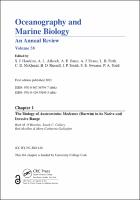Chapter 1 The Biology of Austrominius Modestus (Darwin) in its Native and Invasive Range
Proposal review
| dc.contributor.editor | O'Riordan, Ruth M. | |
| dc.contributor.editor | Culloty, Sarah C. | |
| dc.contributor.editor | Mcallen, Rob | |
| dc.contributor.editor | gallagher, mary catherine | |
| dc.date.accessioned | 2021-03-18T16:09:31Z | |
| dc.date.available | 2021-03-18T16:09:31Z | |
| dc.date.issued | 2020 | |
| dc.identifier.uri | https://library.oapen.org/handle/20.500.12657/47403 | |
| dc.description.abstract | Austrominius modestus, formerly Elminius modestus, is a relatively small species of four-plated acorn barnacle, which is native to the subtropical and temperate zones of Australasia. It was introduced into Europe in the 1940s, where its current range includes England, Scotland, Wales, Ireland and continental Europe from Denmark to southern Portugal, as well as two reported locations in the Mediterranean Sea. This species occurs intertidally and subtidally on a very wide range of substrata in both its native and introduced range and is found on sheltered to intermediate exposed shores, but is absent from wave-exposed shores, probably due to the relative fragility of its shell. A. modestus is known to be both euryhaline and eurythermal, but its physiology (and that of other cirripedes) has been relatively little studied in comparison with other invertebrate species. Cold temperatures and competition from arctic-boreal barnacle species currently control its northern limit. At the southern limit, desiccation stress, or some other stress(es), may be limiting the abundance of Austrominius modestus by affecting cyprids and/or metamorphs at the settlement and recruitment stages. Abundance may also be limited by factors occurring at the reproductive stage. Since Austrominius modestus is an obligatory cross-fertiliser, the need for a critical breeding density is one of the factors that appears to have slowed the speed of its spread in Europe. Although this species can commence reproducing at a very young age and under optimal conditions produces multiple broods per year, its fecundity has not yet been studied. An examination of the age of first brooding, the timing and size and number of broods per year at sites at the northern (Scotland) and southern (Portugal) limits of the current invasive range of Austrominius modestus may provide a better understanding of the factors controlling its geographic distribution, abundance and speed of spread in its non-native range. For instance, warming waters could result in increased reproduction and recruitment of Austrominius modestus, leading to a reduced density of the native Semibalanus balanoides Linnaeus which may drive Semibalanus balanoides to extinction in certain parts of its range. Further research is necessary to determine the functional role of Austrominius modestus in relation to native species in order to understand the implications that changes in abundance and distribution of A. modestus may have for ecosystems. | en_US |
| dc.language | English | en_US |
| dc.subject.classification | thema EDItEUR::P Mathematics and Science::PS Biology, life sciences::PSP Hydrobiology::PSPM Marine biology | en_US |
| dc.subject.classification | thema EDItEUR::R Earth Sciences, Geography, Environment, Planning::RN The environment::RNC Applied ecology::RNCB Biodiversity | en_US |
| dc.subject.classification | thema EDItEUR::T Technology, Engineering, Agriculture, Industrial processes::TQ Environmental science, engineering and technology | en_US |
| dc.subject.classification | thema EDItEUR::R Earth Sciences, Geography, Environment, Planning::RB Earth sciences::RBK Hydrology and the hydrosphere::RBKC Oceanography (seas and oceans) | en_US |
| dc.subject.classification | thema EDItEUR::R Earth Sciences, Geography, Environment, Planning::RN The environment::RNC Applied ecology | en_US |
| dc.subject.classification | thema EDItEUR::P Mathematics and Science::PS Biology, life sciences | en_US |
| dc.subject.classification | thema EDItEUR::P Mathematics and Science::PS Biology, life sciences::PSV Zoology and animal sciences::PSVA Zoology: invertebrates | en_US |
| dc.subject.other | Austrominius modestus, Elminius modestus, four-plated acorn barnacle, subtropical Australasia, Australasian marine life, invasive species, ecosystems, invertebrate species | en_US |
| dc.title | Chapter 1 The Biology of Austrominius Modestus (Darwin) in its Native and Invasive Range | en_US |
| dc.type | chapter | |
| oapen.relation.isPublishedBy | 7b3c7b10-5b1e-40b3-860e-c6dd5197f0bb | en_US |
| oapen.relation.isPartOfBook | 0bf278da-435e-4b61-a3b2-a86d9bb2a5ae | en_US |
| oapen.relation.isFundedBy | 6514ed25-71c1-4e46-b165-a8ea5f2a0b19 | en_US |
| oapen.relation.isbn | 9780367367947 | en_US |
| oapen.imprint | CRC Press | en_US |
| oapen.pages | 79 | en_US |
| peerreview.anonymity | Single-anonymised | |
| peerreview.id | bc80075c-96cc-4740-a9f3-a234bc2598f1 | |
| peerreview.open.review | No | |
| peerreview.publish.responsibility | Publisher | |
| peerreview.review.stage | Pre-publication | |
| peerreview.review.type | Proposal | |
| peerreview.reviewer.type | Internal editor | |
| peerreview.reviewer.type | External peer reviewer | |
| peerreview.title | Proposal review | |
| oapen.review.comments | Taylor & Francis open access titles are reviewed as a minimum at proposal stage by at least two external peer reviewers and an internal editor (additional reviews may be sought and additional content reviewed as required). |

